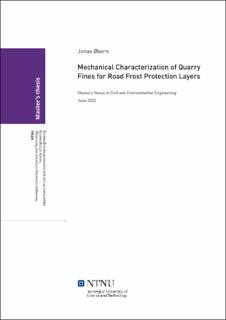| dc.contributor.advisor | Hoff, Inge | |
| dc.contributor.advisor | Barbieri, Diego | |
| dc.contributor.advisor | Skoglund, Kjell Arne | |
| dc.contributor.author | Økern, Jonas | |
| dc.date.accessioned | 2021-09-20T16:15:29Z | |
| dc.date.available | 2021-09-20T16:15:29Z | |
| dc.date.issued | 2020 | |
| dc.identifier | no.ntnu:inspera:57484576:24787390 | |
| dc.identifier.uri | https://hdl.handle.net/11250/2779422 | |
| dc.description.abstract | Formålet med dette studiet er å vurdere de mekaniske egenskapene til tilslags-finstoff, for å evaluere potensialet av å benytte materialet i frostsikringslag i veier. Tilslags-finstoff er underutnyttede overskuddsmaterialer, noe som medfører at nye anvendelser burde utvikles. Derfor ble resilient modulen til to 0/4 mm tilslagsmaterialer bestemt ved hjelp av sykliske treaksialforsøk. Deretter ble lastresponsen til ubundne og lignosulfonat stabiliserte tilslags-finstoff simulert ved numerisk modellering.
12 sykliske treaksialforsøk ble utført med multistage procedure ved lave spenningsnivå. Tilslags-finstoffet ble testet ubundet med 1 % og 7 % vanninnhold, samt med 1.2 % herdet lignosulfonat, for å vurdere effekten av stabilisering med bindemiddel. Resilient modulen i det ubundne materialet var omkring 100-300 MPa for sekvens 1 spenningsnivåer: σd på 20-120 kPa og σt = 20 kPa. Stabilisering med tilsetningsstoffer økte stivheten med en stor, men inkonsekvent margin; ettersom stabilisert resilient modul lå på 400-10000 MPa for de samme sekvens 1 spenningene.
En optimalisert tilpasning til k−θ- og den universelle ocrahedral resilient modul modellen ble etablert ved hjelp av regresjonsanalyse. Den universelle modellen oppnådde R-kvadrat > 0.90 for de fleste ubundne prøvene. Derimot var spredningen i data betydelig etter bindemiddel stabilisering, noe som resulterte i R-kvadrat ε[0.15,0.73].
Lignosulfonat tilsetningen forbedret også mostand mot permanente deformasjoner i tilslags-finstoffet enormt. Spesifikt, ble observert akkumulert plastisk tøyning i treaksialtestene cirka halvert gjennom herdeprosessen. Videre viste treaksiale laststeg langt mer elastisk enn plastisk oppførsel etter stabilisering. Fra disse resultatene ble så en beste tilpasning til en tids-herdet permanent deformasjons-modell utført.
Stabiliserte og ubundne tilslags-finstoff i frostsikringslag ble simulert ved flerlags lineære elastiske og elementmetode analyser, via henholdsvis ERAPave og COMSOL Multiphysics. Simuleringene tok hensyn til ikke-lineær materialoppførsel ved hjelp av de spenningsavhengige regresjonsmodellene som ble opparbeidet fra eksperimentene.
Under lasten av et modulvogntog indikerer den beregnede lastresponsen i tilslags-finstoffs frostsikringslagene at de mekaniske egenskapene er tilstrekkelige for bruk av konseptet. Resultat fra simulering av permanent deformasjon støtter denne konklusjonen, og tyder på at materialet ikke vil utvikle uakseptable permanente deformasjoner ved en eksponering av middels trafikk. | |
| dc.description.abstract | The purpose of this research is to assess the mechanical properties of quarry fines, to evaluate the potential of utilizing the material in road frost protection layers. Quarry fines are underutilized surplus materials, meaning new applications should be developed. For this purpose, the resilient modulus of two 0/4 mm aggregates was determined using repeated load triaxial tests. Then, the load-response of untreated and lignosulphonate stabilized quarry fines frost protection layers was simulated through numerical modeling using the triaxial test data.
12 repeated load triaxial tests were performed with the multistage procedure at low stress levels. The quarry fines were tested untreated at 1 % and 7 % water content, as well as with 1.2 % cured lignosulphonate, to investigate the potential of additive stabilization. The resilient modulus of the untreated fines was approximately 100-300 MPa for sequence 1 stresses: σd of 20-120 kPa and σt = 20 kPa. The additive treatment improved stiffness by a large, but inconsistent magnitude; with a stabilized resilient modulus of roughly 400-10000 MPa for the same sequence 1 stresses.
The best fit for the k−θ and a universal octahedral resilient modulus model was established using regression analyses. The universal model fit achieved R-squared > 0.90 for most of the untreated tests. While post stabilization, the data-scatter was significant, resulting in R-squared ε[0.15,0.73].
The lignosulphonate additive improved the resistance to permanent deformation in the quarry fines substantially. Specifically, the accumulated axial plastic strain in the triaxial tests was approximately halved through stabilization. Also, the triaxial load step strain rates showed considerably more elastic than plastic behavior with the additive treatment. From the triaxial test results, a good fit for a time-hardened permanent deformation model was determined.
Stabilized and untreated quarry fines road frost protection layers were simulated in multiple layer linear elastic and finite element analyses, using respectively ERAPave and COMSOL Multiphysics. The simulations accounted for non-linear elasticity through the triaxial test stress-dependent regression models.
Under tandem rig loads, the calculated load response indicates that the mechanical properties of stabilized quarry fines are sufficient for use as road frost protection layers. Further, the performance modeling supports this conclusion; showing that road frost protection layers with lignosulphonate treated quarry fines will likely not develop excessive permanent deformation when exposed to medium traffic. | |
| dc.language | | |
| dc.publisher | NTNU | |
| dc.title | Mechanical Characterization of Quarry Fines for Road Frost Protection Layers | |
| dc.type | Master thesis | |
